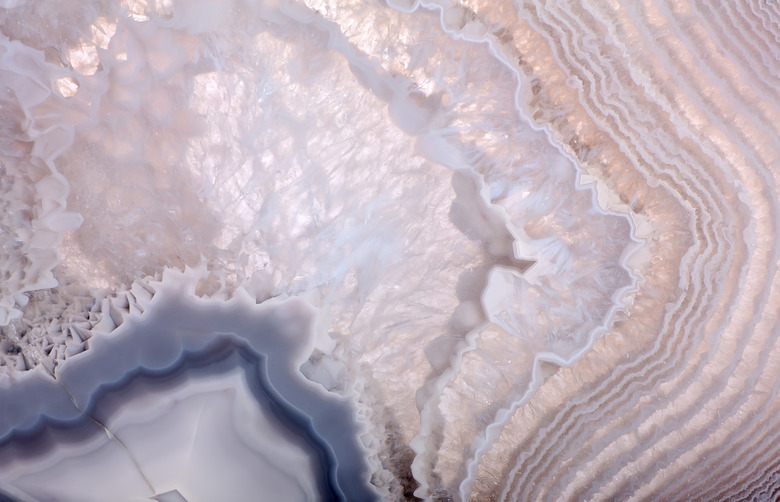Rock Crystals Found In Tennessee
Prized by collectors, Tennessee's rock crystals are really something special. The area around Nashville and Carthage is abundant in high-quality specimens of crystals like sphalerite, fluorite, barite and calcite found in sedimentary limestone rock. In some parts of the state, quartz crystals lie loose at the soil's surface. Here are Tennessee's signature crystals.
TL;DR (Too Long; Didn't Read)
Common rock crystals found in Tennessee include quartz, pyrite sphalerite, galena, fluorite, calcite, gypsum, barite and celestite.
Silicate Group
Silicate Group
Composed of silica, quartz is one of the world's most common crystals. Tennessee quartz is usually clear, but white quartz is also found there. Copper mines at Ducktown have had quartz floors yielding crystals of unusual form and clarity. Quartz geodes are abundant around Center Hill Lake and Cannon County. Loose quartz crystals, known as field diamonds, are found in Greene County, as well as in Douglas Lake, where they're called Douglas diamonds.
Sulfide Group – Metal Ores
Sulfide Group – Metal Ores
Iron pyrite, or fool's gold, forms small, sparkling crystals in coal seams and on quartz, in the same areas where gold and silver occur.
Clumps of dark, lustrous crystals are likely a zinc ore known as sphalerite (zinc sulfide). Sphalerite mines are located mainly in East Tennessee, but the largest is the 300-mile expanse of Elmwood mine.
Galena (lead sulfide) is a metallic-gray, cubic crystal. It's a lead ore found in sedimentary rock, in association with pyrite and sphalerite.
Each mineral in this group has sulfur as part of its chemical formula. Exposed to rainwater and oxygen, sulphide minerals bleed sulfuric acid. Streams in the Cumberland plateau have been so damaged by acid drainage from coal mines that they're declared dead.
Halide Group
Halide Group
Halides are crystals with a halogen – fluorine, chlorine, iodine or bromine – as part of their chemical structure. Fluorite, used in fluoride toothpaste as well as in the aluminum and steel industries, is found as cubic crystals frequently alongside or growing on sphalerite. Tennessee fluorite is a rich, purple-blue color, coveted by collectors. Elmwood mines have yielded exceptionally fine fluorite crystals.
Carbonate Group
Carbonate Group
Calcite is the main component of limestone (calcium carbonate), originally laid down as sediment by warm, shallow seas. In limestone caves, calcite forms stalactites and stalagmites. Large individual crystals in transparent amber shades are found in Tennessee's mines and caves. The shape is a faceted teardrop, or dog's tooth.
Sulfate Group
Sulfate Group
Gypsum (calcium sulfate dihydrate), barite (barium sulfate) and celestite (strontium sulfate) form clusters and rosettes of rod- or blade-shaped crystals.
Gypsum crystals from Tennessee are usually white, but they may be transparent. A natural insulator, gypsum feels warm to the touch. No wonder it's mined to make cement and wallboard.
Barite and celestite are often found together. With its sky-blue hue, celestite appears like shards of ice or broken glass. Where deposits are large, celestite is mined for strontium, used in fireworks and colorants.
Honey-colored barite is found in Carthage as spherical formations resembling dirty snowballs. It's a heavy crystal used in the oil industry to prevent blowouts during drilling. Barite is also used as a filler in paper and in medicine for barium enemas.
Cite This Article
MLA
Wedgwood, Tamasin. "Rock Crystals Found In Tennessee" sciencing.com, https://www.sciencing.com/crystal-rocks-found-tennessee-8258230/. 1 May 2018.
APA
Wedgwood, Tamasin. (2018, May 1). Rock Crystals Found In Tennessee. sciencing.com. Retrieved from https://www.sciencing.com/crystal-rocks-found-tennessee-8258230/
Chicago
Wedgwood, Tamasin. Rock Crystals Found In Tennessee last modified March 24, 2022. https://www.sciencing.com/crystal-rocks-found-tennessee-8258230/
